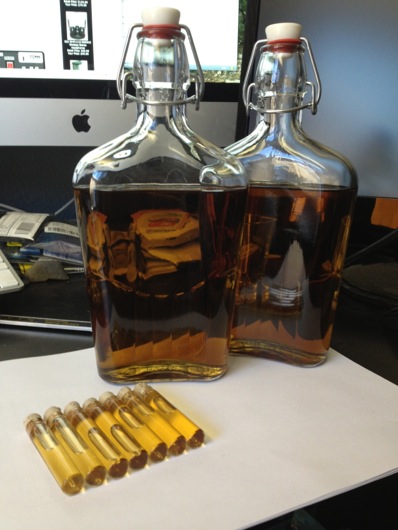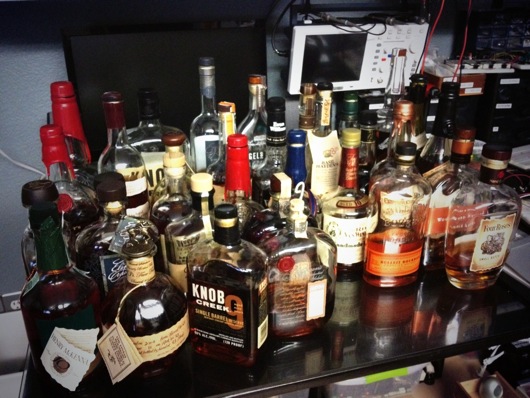I put together a guide pamphlet for our group's annual trip to the Kentucky Bourbon Festival and for the Kentucky Bourbon Trail. It included quite a bit of collected and learned information on my favorite adult beverage: Bourbon. Here's the page that contains the "Bourbon To-Drink" checklist, if you're interested! I thought I would reformat it a little and put it in a blog entry. Here goes...
What is Bourbon?
Here's my definition: Bourbon is a type of whiskey made mostly from corn that has a clear amber or brown color bottled at around 80˚ proof or more and has a complex flavor profile with generally vanilla and wood overtones. Or the quick answer I usually give: Bourbon is delicious sipping alcohol. I ain't met one I hated, yet. Amen.
Contrary to urban legends, bourbon does not have to be made only in Bourbon region of Kentucky or even simply in Kentucky. It can be made anywhere in the Continental United States. In fact, it is the official spirit of the United States by declaration of Congress in 1965.
For those who don't know much about it, bourbon is a type of whiskey. However, not all whiskeys are bourbon. There is even a section of the U.S. CFR (Code of Federal Regulations) (not to be confused with USC: "United States Code" which are the laws we must live by in the U.S.) (CFRs are written when a law [in the USC] is passed that gives a federal agency the authority to make rules [CFRs]) (or so I've figgered out through my own research) (correct me if you feel that's invalid, but I think it's correct enough) (moving on) (this parenthetical for rent) that explains what distinguishes bourbon from other distilled alcohols. Here's a piece of it:
"27 CFR § 5.22 (b) (1) (i) “Bourbon whisky”, “rye whisky”, “wheat whisky”, “malt whisky”, or “rye malt whisky” is whisky produced at not exceeding 160° proof from a fermented mash of not less than 51 percent corn, rye, wheat, malted barley, or malted rye grain, respectively, and stored at not more than 125° proof in charred new oak containers; and also includes mixtures of such whiskies of the same type.
A friendlier breakdown of the types of whiskies out there can be found in the The Beverage Alcohol Manual ("BAM") on the U.S. Department of the Treasury Alcohol and Tobacco Tax and Trade Bureau ("TTB") website. Specifically interesting is Chapter 4: Class and Type Designation. This chapter describes the various types of whiskies in a concise way. Let me summarize the good whiskey/bourbon bits (spelling is a matter of taste, mind you; it does not indicate type or geographical origin or anything):
WHISKY - Spirits distilled from a fermented mash of grain at less than 95% alcohol by volume (190 proof) having the taste, aroma and characteristics generally attributed to whisky and bottled at not less than 40% alcohol by volume (80 proof).
BOURBON WHISKY - Whisky produced in the U.S. at not exceeding 80% alcohol by volume (160 proof) from a fermented mash of not less than 51 percent corn and stored at not more than 62.5% alcohol by volume (125 proof) in charred new oak containers.
STRAIGHT BOURBON WHISKY - Bourbon whisky is stored in charred new oak containers for 2 years or more. “Straight Bourbon Whisky” may include mixtures of two or more straight bourbon whiskies provided all of the whiskies are produced in the same state.
Essentially, it breaks down like this:
- Mash bill is at least 51% corn Distilled to no more than 160º proof (80% alcohol)
- Put into barrel at no more than 125º proof (62.5% alcohol) (may be cut with water)
- Rules say bourbon must be stored in brand new, unused, charred (not toasted) white oak barrels, but do not say for how long
- Must not have any added color or flavoring
- May not be blended with other grain spirits (other than bourbon)
- Must be bottled between 80º to 125º proof (40% to 62.5% alcohol)
- “Straight” bourbon must be aged a minimum of two (2) years
- Age must be noted on bottle if less than 4 years old
- If the age is stated on the bottle, it must be that of the youngest bourbon in the bottle
- To be called, “Kentucky Bourbon,” it must have aged a minimum of one (1) year and one (1) day in the State of Kentucky
The Process of Making Bourbon
This is a VERY rough walk-through of how bourbon is cooked, distilled, stored and bottled. Google if you want more detail than this, but this is generally what you learn from taking distillery tours in Kentucky.
- Grains are milled and placed in cooker with water (typically the iron-free, limestone-filtered water from the springs and creeks near the distillery) and some of the previous batch, or “sour mash” (sometimes called the “set back”), and then cooked.
- The cooked mash is put into the fermenter along with yeast.
- Over the next handful of days, the yeast chow down on the sugars in the mash, heat it up, fart CO2, pee alcohol and turn the mash into “distiller’s beer.”
- The distiller’s beer, which is the grains and all, is then distilled in a column still and out of its condenser you get “low wine” with no grains. Low wine is roughly 125º proof (62.5% yeast pee).
- The low wine is then distilled into “high wine” in the “doubler.” The high wine is at about 135º proof (67.5% yeast pee).
- The high wine is then pumped into a holding tank where it must be cut with more branch water, as it must enter the barrels for aging at no more than 125º proof, or 62.5% yeast pee.
- The the corn whiskey or “white dog” or “white lightening” or “moonshine” is pumped into brand new, charred, white oak barrels to be aged for a minimum of two years.
- The barrels are placed in warehouses that are designed to allow mother nature to run the climate control. Some distillers move the barrels around during aging.
- The master distiller samples bourbon directly from a barrel with a tool called a “whiskey thief,” which allows him to “grab” a little bourbon and drop it into a glass. Once the master distiller feels a barrel is ready for the bottle, the barrel is removed from the warehouse and emptied. If they’re making a “single barrel” bourbon, one barrel will fill bottles. If they’re making a “small batch” bourbon, a small number of other barrels will be combined or blended and then bottled.
- Now, if you’re Maker’s Mark, this is where you dip the necks of the bottles in the famous red wax. You’ll learn all about the story behind the Maker’s Mark marketing on their tour, of course. Of course, they're not the only one that does this: Copper State is dipped in copper-colored wax, Knob Creak in black wax, etc.
- They ship it.
- We buy it.
- We drink it!
- Yum.
I aged my own bourbon last year. It was cool, but I'm too impatient for that.
Sampling and Tasting
I don't know that there needs to be a whole section on this. More importantly, sample and taste bourbon (or anything) however you feel comfortable doing it. I'm just telling you how I do it and it has worked very well for me. Sometimes I see people throwing back shots of really nice bourbon while their supposed to be sampling it and it makes be cringe, but that's me. I'm not a bourbon snob, I just enjoy it and I enjoy its history and little factoids. So, here's a tiny explanation of how I sip and sample...
Any glass will do, really, but these little whiskey glasses I picked up at the local booze mega store make it easier to swirl the bourbon around and nose (smell) it. Plus, as much as I think I could pour myself a full 6-ounce glass of the stuff, I usually drink it in shot or double-shot quantities in a sitting. So, these little guys work great. Elijah Craig 18-year Single Barrel works great as a demo, too!
First off, when you uncap your bottle, pour the bourbon and put the cap right back on. Evaporation and oxygen are no bueno. I can tell when the oxygen is getting to the bourbons in my cabinet: The bottles with just a portion left are the most vulnerable. I'm working on a plan to protect the bourbon better with something like a nitrogen system or something. I typically have between 30 and 40 different kinds (not bottles) of bourbon (a couple "other" whiskeys) in my bourbon cabinet (see photo) and that probably equates to over $1,000 in liquor. It would be super-swell to not have it oxidize or fade in flavor. However, unlike wine, bourbon doesn't age more in the bottle. Once it's out of the barrel, it's done aging in the sense of how bourbon is aged.
Swirl the bourbon around in the glass. Stick your nose over and maybe even just slightly into the opening of the glass. Breathe in the vapors with your nose AND your mouth slightly open and you'll get a bigger, better sample of the nose of the bourbon over your nose and taste buds. This is where I notice almost always catch vanilla, caramel and woody flavors. As you do that a number of times, you'll notice there are usually WAY more components to the nose of bourbon that those three. It's amazing to do this with several different bourbons in a row.
If you're new to bourbon, sip a super tiny bit from the glass. I'm talking a handful of drops, here. If you feel an alcohol burn on the tip of your tongue, try again and this time immediately "chew" it (I think I saw Booker Noe once call this the "Kentucky chew") and swish it around in your mouth a bit. The chew is simply smacking it against the top of your mouth and moving it around over and over for a little bit. It busts open the flavors of the bourbon in your mouth. It's quite amazing. You can even bring in a little outside air to get the olfactory senses involved. Mmmm! Yum!
The flavor changes from the front of your tongue to the back and on the sides. Moving it around lets you pick up just about all of the notes in the flavor.
How I Came to LOVE Bourbon
This story has been told a million times before: Because of a bad experience (youth = poor choices = learning) in college, I became a non-fan of hard liquor. The disdain for hard liquor and even the smell of it went on for many, many years. I would say, now, those years were lost. I have since come to appreciate bourbon and, I guess, whiskey in general, although I'm not a fan of Scotch, it's OK. I can sip good reposado tequila, but it's not my thing in general.
One day, while on the distillery tour at Jack Daniel's in Lynchburg, TN, I rediscovered whiskey (in vapor form, anyway). On that tour, you get to see the tops of the mellowing towers. These a indoor silos of charcoal made on the property. They slowly drip the white lightning Jack, fresh from the still (technically from the holding tank, I suppose), through these giant silos of charcoal. This would be one of the reasons some argue that Jack Daniel's Tennessee Sour Mash Whiskey is not technically bourbon. Rules say you cannot mess with (add flavor or color to) the distilled product (other than cutting it to proper proof) before it goes in a barrel. I believe the argument might be that the charcoal imparts flavor, but Jack Daniel's touts it as taking the edge off. I dunno. It's still pretty tasty. I love their Single Barrel. Anyway, back to our story... The tour guide asks you to put your face right at the edge of the top of one of these silos and breathe in the flavor of the whiskey fumes while he puffs the lid of the silo. What you get is the flavor of the whiskey without drinking any. Good thing, too, because Lynchburg is in a dry county (although, you can sample at the distillery, now). True story.
My buddy and I drove back to Nashville and stopped at a bar in the hotel and sipped shots of Old No. 7. For the first time (thanks for nothing, college party experiences), I took small little sips of the whiskey and chewed on it and swished it around and truly savored the whiskey's complex flavors. The biggest surprise to me was the sweetness. All I'd ever noted about the flavor of whiskey was how it burned my mouth and throat and was exactly what I imagined funny car fuel would taste like. While slamming a full shot might make it seem like that's the case, it's not true (mostly)! It's absolutely delicious and the more you sip and sample, the more you appreciate how wonderful whiskey really is. I said, "mostly," because some bourbons do have a peppery taste or are quite high in proof. Sensitive taste buds will feel the burn, for sure.
Summary
Hmmm... Summary... How to summarize...? How about this? Bourbon is delicious.








